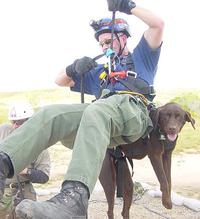-
Data indicate there is no immigration crisis
Is there an “immigration crisis” on the U.S.-Mexico border? Not according to an examination of historical immigration data, according to a new study. The paper examines historical immigration data, the “push” and “pull” factors currently motivating Mexicans and Central Americans to migrate to the United States and attempts to explain why current undocumented immigration across the U.S.-Mexico border has been perceived as a crisis.
-
-
Border Patrol canines are outfitted with wearable electronics

Wearable electronics are expected to generate more than $14 billion in 2014, and the market will reach $70 billion by 2024.Wearable devices have been integrated into the daily tasks performed by Border Patrol agents. Thousands of border agents are currently outfitted with smart wrist-watches, wearable cameras, and clothing equipped with health and safety sensors capable of monitoring body temperatures and stress levels.Border Patrol canines are outfitted with GPS-connected collars which allow border agents to keep track of their whereabouts.
-
-
Report on CBP agent border shooting: “Police don’t get to shoot someone in the back because they beat you up”

A new, detailed report provides an in-depth look into a border shooting involving a CBP agent. Juan Mendez Jr., 18, an American citizen, was shot twice by Agent Taylor Poitevent and died at the scene. Following an investigation, Poitevent was not charged with any violations in the shooting death of Mendez. To date there are more than forty border fatalities involving CBP agents since 2005 which have remained virtually closed to public scrutiny. Thomas Herrera, former Maverick County, Texas sheriff, remains doubtful of Poitevent’s innocence. “Resisting arrest does not give an officer the right to kill someone,” Herrera said.
-
-
Former head of Internal Affairs at CBP: Agency suffers from “institutional narcissism”; conducting its affairs beyond “constitutional constraints”
In what may become the most explosive scandal in the history of the U.S. Border Patrol, James F. Tomsheck, former head of Internal Affairs at U.S. Customs and Border Protection (CBP), accused his own agency of protecting its agents from criminal charges, including murder, corruption, and graft. Tomsheck also directly pointed the finger at CBP senior management, including former Commissioner Alan Bersin and Chief David Aguilar. Tomsheck, who served until June of this year as the head of internal affairs for U.S. Customs and Border Protection, characterized his agency as suffering from “institutional narcissism” and maintaining a culture which allowed its agents to act beyond “constitutional constraints”
-
-
Mexico should do more to stem tide of Central American children reaching U.S.: Experts
While Congress and the White House struggle to pass a bipartisan solution to the influx of Central American children and families crossing the U.S.-Mexico border, some immigration experts are urging the Obama administration to put more pressure on the Mexican government to secure its border with Guatemala and Belize. Illegal migration into the United States from Mexico is at its lowest levels in four decades, but the share of Central American migrants detained along the U.S. southern border is at its highest.
-
-
DHS IG finds problems in detention centers for undocumented immigrants
A DHS IG report finds problems in several detention centers for Central American children and families who recently crossed the U.S.-Mexico border, including inadequate food supplies, temperature-control problems, and a high employee-to-detainee ratio.
-
-
Immigration cases clog immigration courts across the country
The highly publicized mass immigration of Central American children into the United States — roughly 57,000 over a little under a year — many court systems are facing a crisis as the number of judges, lawyers, and juries available cannot keep up with demand. Across the United States, that caseload reached 375,373 trials last month — an average of 1,500 per each of the country’s 243 immigration judges. Some rescheduled cases are being pushed back as late as 2017.
-
-
Does the border really need Perry’s 1,000 National Guard?
Various solutions to the two and one-half year surge at the border by unaccompanied children from Honduras, Guatemala, and El Salvador have been proposed by Congress, law enforcement, the public, and politicians with a dog in the fight. The increase in unaccompanied children seeking asylum, however, should be defined less as a border security problem, and more as a refugee problem. At the same time, this newest border dilemma reemphasizes Congress’s failure to pass comprehensive immigration reform that could calmly address this and other real border issues, all problems with which individual states like Texas have had to contend since 1986.
-
-
U.S. mulls ways to handle complex child immigration issue
The influx of unaccompanied children crossing into the United States has reached crisis proportions, with 90,000 now in the United States. The children are escaping violence and deprivation in Honduras, Guatemala, and El Salvador, but a George W. Bush-era law prevents their rapid repatriation. Leading Republicans want to change the law, but many Democrats condition such a change on folding it into a comprehensive immigration reform.
-
-
Effectiveness of Texas National Guard border troop surge questioned
Texas governor Rick Perry’s plan to send nearly 1,000 Texas National Guardtroops to the Rio Grande Valley has been applauded by the governor’s supporters, but critics question its effectiveness. Gov. Perry’s decision to send nearly 1,000 guardsmen to the Rio Grande Valley is described as “symbolic,” and top officials in border counties agree that sending more guardsmen to the border would bring little change to the current situation.
-
-
Wave of illegal children immigrants shifts debate on use of executive powers

After several immigration bills stalled in Congress, President Barack Obama, in 2012 and 2013, issued a series of executive orders to limit the number of deportations of illegal immigrants. Many who advocated a tougher stance on immigration have charged Obama with failure to consult with Congress. The Obama administration is now trying to find a way to deport Central American illegal immigrants, many of them unaccompanied children, without running afoul of a George W. Bush 2008 law which makes such deportation difficult – and some of his immigration criticswant him to take executive action on the issue, a shift from their usual criticism that he has abused his executive powers.
-
-
No extra funding for increased Pentagon presence on southern border
Marine Corps Gen. John Kelly, commander of U.S. Southern Command (SOUTHCOM), has stated that illegal immigration and its effects are threatening to destabilize the region and are a national security threat to the United States. President Barack Obama’s $3.7 billion supplemental request to congress, however,, does not include any additional funding for military operations.
-
-
Efforts to discourage unaccompanied minors from entering U.S. have so far failed
The administration’s efforts to discourage children from Central America and Mexico from illegally entering the United States continue to gain little traction, and the number of migrants under eighteen years old illegally crossing the U.S-Mexico border continues to increase. Officials blame the surge in young migrants on the William Wilberforce Trafficking Victims Protection Reauthorization Act, a 2008 law which made it difficult to repatriate unaccompanied minors without letting then appear before an immigration judge. The administration has asked Congress to change the 2008 law to give DHS greater discretion in repatriating Central American children more quickly, but some Senate Democrats have vowed to block narrow changes to immigration laws.
-
-
State collapse in the hemisphere an “existential” threat to U.S.: Southern Command chief
Marine Corps Gen. John Kelly, commander of U.S. Southern Command, is asking Congress to allocate more resources to help combat the flow of illegal drugs, weapons, and people from Central America. “In comparison to other global threats, the near collapse of societies in the hemisphere with the associated drug and (undocumented immigrant) flow are frequently viewed to be of low importance,” Kelly said. “Many argue these threats are not existential and do not challenge our national security. I disagree.”
-
-
2015 DHS budget is border patrol “wish list”: critics
Last week, the House Appropriations Committee approved $39.2 billion 2015 budget for the Department of Homeland Security (DHS). Critics were quick to point out that many items in the budget were not on the original budget request, but were since added after showing up originally on a wish list of hardware that could improve and extend the surveillance capabilities of DHS.
-
- All
- Regional
- Water
- Biometrics
- Borders/Immig
- Business
- Cybersecurity
- Detection
- Disasters
- Government
- Infrastructure
- International
- Public health
- Public Safety
- Communication interoperabillity
- Emergency services
- Emergency medical services
- Fire
- First response
- IEDs
- Law Enforcement
- Law Enforcement Technology
- Military technology
- Nonlethal weapons
- Nuclear weapons
- Personal protection equipment
- Police
- Notification /alert systems
- Situational awareness
- Weapons systems
- Sci-Tech
- Sector Reports
- Surveillance
- Transportation
Advertising & Marketing: advertise@newswirepubs.com
Editorial: editor@newswirepubs.com
General: info@newswirepubs.com
2010-2011 © News Wire Publications, LLC News Wire Publications, LLC
220 Old Country Road | Suite 200 | Mineola | New York | 11501
Permissions and Policies
Editorial: editor@newswirepubs.com
General: info@newswirepubs.com
2010-2011 © News Wire Publications, LLC News Wire Publications, LLC
220 Old Country Road | Suite 200 | Mineola | New York | 11501
Permissions and Policies
